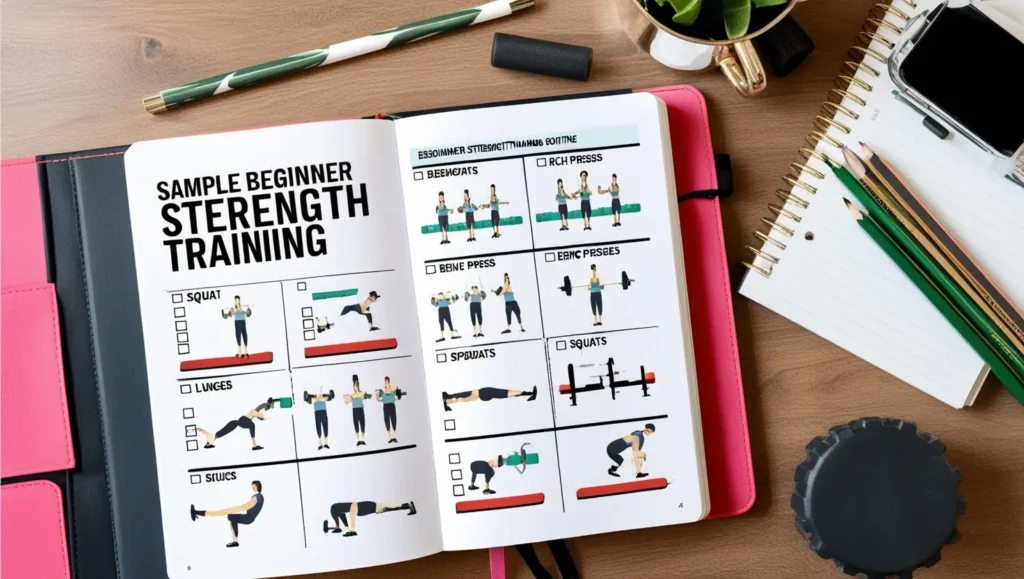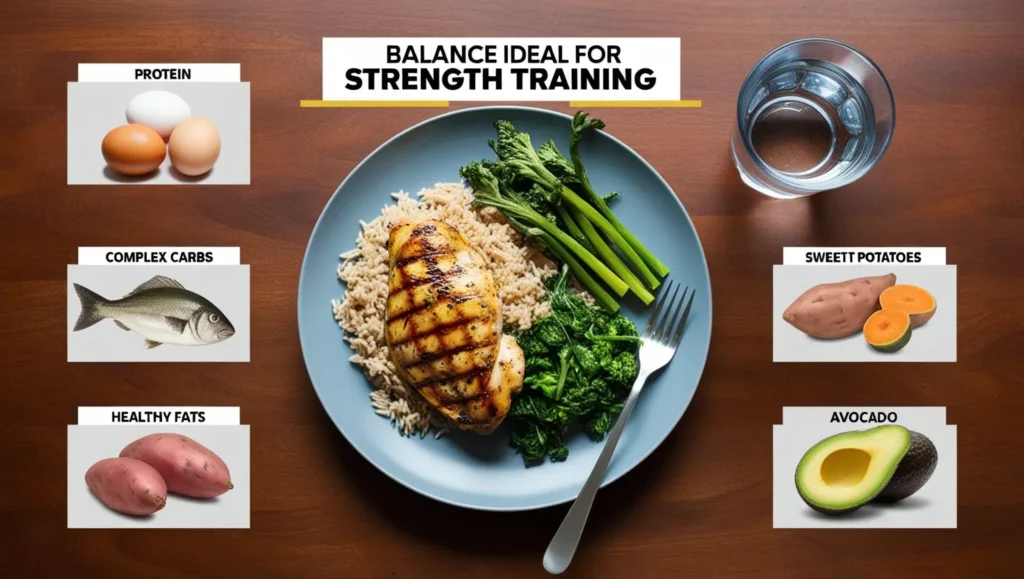Table of Contents
What is Strength Training?

Welcome to the beginner’s guide to strength training! If you’re new to the world of fitness, strength training might seem intimidating. But don’t worry—it’s simpler than you think.
Strength training, also known as resistance training or weight training, involves exercises that improve your muscle strength and endurance.
By incorporating a beginner strength routine into your life, you can build muscle, burn fat, and boost your overall health.
Strength training isn’t just for bodybuilders or athletes. It’s for anyone who wants to improve their physical health and feel stronger in daily activities.
Whether you prefer working out at the gym or in the comfort of your home, there are numerous ways to start weight training effectively.
In this guide, we’ll walk you through everything you need to know about starting strength training. From understanding key terminologies like reps and sets, to learning beginner-friendly exercises and nutrition tips, we’ve got you covered.
Let’s embark on this journey to build strength, enhance fitness, and improve your quality of life!
Why Start Strength Training? Benefits for Health and Fitness

Starting a strength training regimen offers numerous benefits that go beyond just building muscles. Let’s delve into some compelling reasons why you should incorporate strength and conditioning exercises into your fitness routine.
1. Build and Maintain Muscle Mass
As we age, our muscle mass naturally declines. Strength training helps build muscle and prevent muscle loss. Regular resistance exercises stimulate muscle growth by challenging your muscles to work harder than they’re accustomed to.
This process leads to increased muscle strength and size, improving your physical appearance and performance.
2. Boost Metabolism and Burn Fat
Muscle tissue burns more calories than fat tissue, even at rest. By increasing your muscle mass through strength training, you enhance your body’s ability to burn calories more efficiently. This boost in metabolic rate aids in fat loss and helps maintain a healthy body weight.
3. Improve Bone Health
Strength training puts stress on your bones, which stimulates bone growth and increases bone density. This is crucial for preventing osteoporosis and reducing the risk of fractures, especially as you age.
Incorporating resistance training into your routine strengthens your skeletal system and promotes long-term bone health.
4. Enhance Joint Flexibility and Balance
Regular strength exercises improve joint flexibility and stability. Strong muscles support your joints, reducing the risk of injuries and improving your balance.
This is particularly beneficial for older adults, helping them maintain independence and reduce falls.
5. Elevate Mood and Reduce Stress
Engaging in weight training releases endorphins, the body’s natural mood elevators. These hormones help reduce stress, anxiety, and symptoms of depression.
Regular workouts can improve your mental health, boost self-esteem, and enhance overall well-being.
6. Increase Energy Levels
Contrary to what you might think, exercising regularly actually increases your energy levels. Strength training improves your body’s efficiency, making everyday tasks feel easier and less tiring.
You’ll notice increased stamina and endurance in both physical and mental activities.
7. Improve Heart Health
Strength training contributes to better cardiovascular health by lowering blood pressure, improving cholesterol levels, and reducing the risk of heart disease.
Incorporating strength and conditioning exercises into your routine supports a healthy heart and circulatory system.
8. Enhance Athletic Performance
Whether you’re into sports or just enjoy being active, strength training can significantly improve your performance. Stronger muscles mean better speed, power, and agility.
This translates to improved abilities in various physical activities, from running and swimming to playing team sports.
9. Support Healthy Aging
Strength training helps maintain independence and quality of life as you age. It preserves muscle mass, strengthens bones, and improves balance, making daily activities easier and reducing the risk of age-related health issues.
10. Customize to Any Fitness Level
One of the great things about strength training is its versatility. You can tailor exercises to fit your current fitness level and progress at your own pace.
Whether you’re a complete beginner or looking to advance your routine, strength training offers endless possibilities for customization.
In summary, starting a strength training regimen is a powerful step toward improving your physical and mental health. The benefits are extensive and impactful, touching every aspect of your well-being. Ready to get started? Let’s dive into the basics!
Key Terminologies: Understanding Reps, Sets, and More

Before jumping into your beginner strength routine, it’s essential to understand some fundamental terms. Knowing these will help you follow workout plans accurately and communicate effectively about your training.
1. Repetitions (Reps)
A repetition, or rep, refers to one complete movement of an exercise. For example, lifting a dumbbell from your side up to your shoulder and back down once is one rep of a bicep curl. The number of reps you perform depends on your fitness goals and the specific exercise.
2. Sets
A set is a group of consecutive repetitions performed without rest. For instance, doing 10 bicep curls in a row constitutes one set of 10 reps.
After completing a set, you typically take a short rest before starting the next set. Workouts are often structured with multiple sets for each exercise.
3. Rest Periods
Rest periods are short breaks taken between sets and exercises. Rest allows your muscles to recover partially before the next effort. The length of rest periods can vary based on your goals:
- Strength and Power: Longer rest periods (2-3 minutes)
- Muscle Growth: Moderate rest periods (60-90 seconds)
- Endurance and Fat Loss: Shorter rest periods (30-60 seconds)
4. Intensity
Intensity refers to the amount of effort you’re putting into an exercise. In strength training, intensity is often measured by the amount of weight lifted relative to your maximum capacity.
Higher intensity involves lifting heavier weights for fewer reps, while lower intensity involves lighter weights for more reps.
5. Volume
Volume is the total amount of work done during a training session. It’s calculated by multiplying the number of sets by the number of reps and the weight lifted. For example, if you perform 3 sets of 10 reps with 20 pounds, your volume for that exercise is 600 pounds (3 x 10 x 20).
6. Progressive Overload
Progressive overload is the gradual increase of stress placed on the body during exercise. This principle is fundamental for continuous improvement in strength and muscle mass.
You can achieve progressive overload by increasing weight, reps, sets, or decreasing rest time over weeks and months.
7. Range of Motion (ROM)
Range of Motion refers to the full movement potential of a joint or exercise. Performing exercises through a complete ROM ensures that you’re effectively working the targeted muscles and maintaining joint health.
8. Form and Technique
Form and technique describe the correct way to perform an exercise. Proper form ensures that you’re targeting the intended muscles and reduces the risk of injury. It’s crucial to learn and maintain good technique, especially as you start adding weight.
9. Compound Exercises
Compound exercises involve multiple joints and muscle groups simultaneously. Examples include squats, deadlifts, and bench presses. These exercises are efficient for building overall strength and muscle mass.
10. Isolation Exercises
Isolation exercises target a single joint and specific muscle group. Examples include bicep curls and leg extensions. These exercises are useful for focusing on and strengthening particular muscles.
11. Warm-up and Cool-down
A warm-up involves light activities performed before your workout to prepare your body and prevent injury. A cool-down is performed after your workout to help your body recover and reduce muscle soreness. Both are essential parts of a safe and effective training session.
Understanding these terms will help you navigate workout routines and communicate with fitness professionals more effectively. With this knowledge, you’re well-equipped to embark on your strength training journey confidently.
Getting Started: Beginner-Friendly Exercises and Routines

Now that you understand the basics, it’s time to dive into action. Starting a beginner strength routine doesn’t have to be complicated. Focus on simple, effective exercises that target all major muscle groups. Here’s how to get started.
1. Setting Up Your Workout Schedule
For beginners, aim for 2-3 strength training sessions per week, with at least one day of rest between sessions to allow your muscles to recover. Each session should last between 45 minutes to an hour, including warm-up and cool-down.
Sample Weekly Schedule:
- Monday: Strength Training
- Tuesday: Rest or Light Cardio
- Wednesday: Strength Training
- Thursday: Rest or Light Cardio
- Friday: Strength Training
- Saturday: Rest or Active Recovery
- Sunday: Rest
2. Essential Equipment
You don’t need fancy equipment to start strength training. Here’s a list of basic tools:
- Bodyweight: Perfect for beginners; uses your own body as resistance.
- Dumbbells: Versatile and available in various weights.
- Resistance Bands: Affordable and great for adding resistance.
- Kettlebells: Useful for dynamic movements.
- Barbells and Weight Plates: For heavier lifting as you progress.
- Gym Machines: Provide guided movements and are beginner-friendly.
3. Warm-up Routine
Always start with a 5-10 minute warm-up to prepare your body. Include light cardio and dynamic stretches.
Sample Warm-up:
- 5 minutes: Light jogging or brisk walking.
- Dynamic Stretches:
- Arm circles
- Leg swings
- Hip rotations
- Bodyweight squats
- Lunges with rotation
4. Beginner-Friendly Exercises
Focus on compound exercises that work multiple muscle groups. Here’s a list of effective exercises to include in your routine.
Upper Body Exercises
1. Push-Ups
- Targets: Chest, shoulders, triceps, core.
- How to Perform:
- Start in a plank position with hands shoulder-width apart.
- Lower your body by bending elbows until your chest nearly touches the floor.
- Push back up to the starting position.
- Modification: Perform on knees if standard push-ups are too challenging.
2. Dumbbell Rows
- Targets: Back, biceps, shoulders.
- How to Perform:
- Place your left knee and hand on a bench for support.
- Hold a dumbbell in your right hand, arm extended toward the floor.
- Pull the dumbbell toward your hip, squeezing your back muscles.
- Lower back down and repeat. Switch sides after completing reps.
3. Overhead Press
- Targets: Shoulders, triceps, upper back.
- How to Perform:
- Stand with feet shoulder-width apart, holding dumbbells at shoulder height.
- Press the weights overhead until arms are fully extended.
- Lower back down to shoulder height and repeat.
4. Bicep Curls
- Targets: Biceps.
- How to Perform:
- Stand with feet hip-width apart, holding dumbbells at your sides.
- Curl the weights toward your shoulders by bending elbows.
- Lower back down slowly and repeat.
Lower Body Exercises
1. Squats
- Targets: Quadriceps, hamstrings, glutes, core.
- How to Perform:
- Stand with feet shoulder-width apart.
- Lower your body by bending knees and pushing hips back as if sitting on a chair.
- Keep your chest up and back straight.
- Push through your heels to return to the starting position.
2. Lunges
- Targets: Quadriceps, hamstrings, glutes, calves.
- How to Perform:
- Stand upright with feet hip-width apart.
- Step forward with your right foot, lowering your body until both knees are bent at 90 degrees.
- Push through your right heel to return to the starting position.
- Repeat on the left side.
3. Glute Bridges
- Targets: Glutes, hamstrings, core.
- How to Perform:
- Lie on your back with knees bent and feet flat on the floor hip-width apart.
- Lift your hips by squeezing your glutes until your body forms a straight line from shoulders to knees.
- Lower back down and repeat.
4. Calf Raises
- Targets: Calves.
- How to Perform:
- Stand with feet hip-width apart.
- Raise your heels off the ground by contracting your calf muscles.
- Lower back down slowly and repeat.
Core Exercises
1. Plank
- Targets: Core, shoulders, back.
- How to Perform:
- Start in a push-up position, but rest on your forearms instead of hands.
- Keep your body in a straight line from head to heels.
- Hold this position for 30 seconds to a minute, maintaining proper form.
2. Bicycle Crunches
- Targets: Abs, obliques.
- How to Perform:
- Lie on your back with hands behind your head.
- Lift your shoulders off the ground and bring your right elbow toward your left knee while straightening the right leg.
- Switch sides in a pedaling motion and repeat.
3. Russian Twists
- Targets: Obliques, abs.
- How to Perform:
- Sit on the floor with knees bent and feet lifted slightly off the ground.
- Lean back slightly and hold your hands together in front of you.
- Twist your torso to the right, then to the left, touching the floor beside you each time.
5. Sample Beginner Workout Routine

Here’s a simple full-body routine to perform three times a week:
Workout A
- Squats: 3 sets x 12 reps
- Push-Ups: 3 sets x 10 reps
- Dumbbell Rows: 3 sets x 12 reps (each arm)
- Glute Bridges: 3 sets x 15 reps
- Plank: 3 sets x 30 seconds
Workout B
- Lunges: 3 sets x 10 reps (each leg)
- Overhead Press: 3 sets x 12 reps
- Bicep Curls: 3 sets x 12 reps
- Calf Raises: 3 sets x 15 reps
- Russian Twists: 3 sets x 20 reps (each side)
Weekly Schedule Example:
- Monday: Workout A
- Wednesday: Workout B
- Friday: Workout A (alternate workouts each session)
Tips:
- Rest: Take 60-90 seconds rest between sets.
- Progression: Start with light weights and focus on form. Gradually increase weight or reps as you get stronger.
- Listen to Your Body: If an exercise causes pain, stop and assess your form or choose a modification.
- Consistency: Stick to your schedule and be patient. Strength gains take time and dedication.
6. Cool-down Routine
Finish your workout with a 5-10 minute cool-down to help your body recover.
Sample Cool-down:
- Light Cardio: 3-5 minutes of walking or slow cycling.
- Static Stretches:
- Hamstring stretch
- Quad stretch
- Chest stretch
- Shoulder stretch
- Triceps stretch
In conclusion, starting with these basic exercises and routines sets a strong foundation for your strength training journey. Remember, consistency and proper form are key. As you progress, you can introduce more advanced exercises and increase intensity to continue challenging your body.
Nutrition 101: Eating Right for Strength Gains

Proper nutrition is as important as your workouts when it comes to building strength and muscle. What you eat fuels your training and aids in recovery. Let’s explore the fundamentals of nutrition for strength training.
1. Macronutrients: The Building Blocks
Macronutrients—proteins, carbohydrates, and fats—provide the energy and components necessary for muscle growth and repair.
Protein
- Role: Essential for building and repairing muscle tissue.
- Sources:
- Animal-based: Chicken, beef, fish, eggs, dairy products.
- Plant-based: Beans, lentils, tofu, nuts, and seeds.
- Recommended Intake: Aim for 1.2 to 2.0 grams of protein per kilogram of body weight per day, depending on training intensity.
Carbohydrates
- Role: Primary energy source for workouts and replenishing glycogen stores.
- Sources:
- Complex carbs: Whole grains, oats, brown rice, sweet potatoes, quinoa.
- Simple carbs: Fruits, honey, milk.
- Recommended Intake: Carbs should make up about 45-65% of your daily calorie intake.
Fats
- Role: Supports hormone production and provides long-lasting energy.
- Sources:
- Healthy fats: Avocado, olive oil, nuts, seeds, fatty fish.
- Recommended Intake: Fats should constitute about 20-35% of your daily calorie intake.
2. Micronutrients: Vitamins and Minerals
Micronutrients are vital for overall health, energy production, and muscle function.
- Calcium: Supports bone health; found in dairy, leafy greens.
- Iron: Essential for oxygen transport; found in red meat, beans, spinach.
- Vitamin D: Aids in calcium absorption; obtained from sunlight, fatty fish, fortified foods.
- Magnesium: Supports muscle function and energy production; found in nuts, seeds, whole grains.
- Zinc: Important for protein synthesis; found in meat, nuts, legumes.
Ensure a balanced diet rich in fruits and vegetables to meet your micronutrient needs.
3. Hydration
Staying hydrated is crucial for optimal performance and recovery.
- Daily Intake: Aim for 2-3 liters of water per day, more if you’re training intensely.
- During Workouts: Sip water throughout your training session to replace fluids lost through sweat.
4. Meal Timing
When you eat can influence your energy levels and recovery.
Pre-Workout Meal:
- Timing: Eat 1-3 hours before training.
- Composition: Include carbohydrates for energy and a moderate amount of protein.
- Examples:
- Oatmeal with fruits and nuts.
- Whole-grain toast with peanut butter and banana.
- Grilled chicken with sweet potato.
Post-Workout Meal:
- Timing: Consume within 30-60 minutes after training.
- Composition: Combine protein for muscle repair and carbohydrates to replenish glycogen.
- Examples:
- Protein shake with fruit.
- Greek yogurt with berries and granola.
- Tuna sandwich on whole-grain bread.
5. Calorie Intake and Body Composition
Your calorie intake should align with your fitness goals.
- Muscle Gain:
- Calorie Surplus: Consume more calories than you burn.
- Focus: High-protein diet with adequate carbs and healthy fats.
- Fat Loss:
- Calorie Deficit: Consume fewer calories than you burn.
- Focus: Maintain protein intake to preserve muscle mass while reducing carbs and fats moderately.
Use online calorie calculators to estimate your daily needs based on age, gender, weight, activity level, and goals.
6. Supplements
While whole foods should be your primary nutrient source, some supplements can support your training.
- Protein Powder: Convenient way to meet protein needs, especially post-workout.
- Creatine: Supports energy production and enhances strength and muscle gains.
- Branched-Chain Amino Acids (BCAAs): May aid in muscle recovery and reduce soreness.
- Multivitamins: Ensure adequate intake of essential vitamins and minerals.
- Fish Oil: Provides omega-3 fatty acids beneficial for heart health and reducing inflammation.
Note: Consult with a healthcare professional before starting any supplement regimen.
7. Sample Meal Plan
Here’s a sample day of eating for a beginner strength trainee aiming for muscle gain:
Breakfast:
- Scrambled eggs (3 eggs) with spinach and tomatoes.
- Two slices of whole-grain toast with avocado.
- A cup of mixed berries.
- Glass of water or green tea.
Mid-Morning Snack:
- Greek yogurt with a handful of almonds and honey.
Lunch:
- Grilled chicken breast.
- Quinoa salad with mixed vegetables (bell peppers, cucumbers, cherry tomatoes) and olive oil dressing.
- An apple.
Pre-Workout Snack (1 hour before training):
- Banana with a tablespoon of peanut butter.
Post-Workout Shake:
- Protein powder blended with almond milk and a handful of frozen berries.
Dinner:
- Baked salmon fillet.
- Roasted sweet potatoes.
- Steamed broccoli and carrots.
- Side salad with mixed greens and vinaigrette.
Evening Snack:
- Cottage cheese with sliced peaches.
Hydration:
- Drink water throughout the day, aiming for at least 3 liters.
In summary, proper nutrition fuels your workouts and supports recovery, playing a critical role in achieving your strength training goals. Focus on balanced, nutrient-dense meals, stay hydrated, and listen to your body’s needs. Combining effective training with solid nutrition sets you on the path to success.
Common Pitfalls: Avoiding Beginner Mistakes

Starting a new fitness journey can be exciting, but it’s easy to make mistakes along the way. Recognizing and avoiding common pitfalls will help you progress safely and effectively. Here’s what to watch out for.
1. Skipping Warm-ups and Cool-downs
Mistake: Diving straight into intense workouts without proper warm-up or neglecting cool-down stretches.
Why It’s a Problem:
- Increases risk of injury.
- Leads to muscle stiffness and soreness.
- Reduces overall performance.
Solution:
- Always start with a 5-10 minute warm-up involving light cardio and dynamic stretches.
- Finish your workout with a cool-down that includes static stretches to aid recovery.
2. Poor Form and Technique
Mistake: Performing exercises with incorrect form.
Why It’s a Problem:
- Increases risk of injuries.
- Reduces effectiveness of exercises.
- Leads to imbalanced muscle development.
Solution:
- Learn proper technique from reputable sources or professionals.
- Start with lighter weights to focus on form.
- Consider working with a certified trainer for guidance.
3. Lifting Too Heavy Too Soon
Mistake: Attempting to lift heavy weights without building a foundation.
Why It’s a Problem:
- Causes strain and potential injuries.
- Hampers proper form and technique.
- Leads to frustration and burnout.
Solution:
- Begin with manageable weights and gradually increase as you get stronger.
- Prioritize mastering form over lifting heavy.
- Follow the progressive overload principle responsibly.
4. Overtraining and Not Allowing Adequate Rest
Mistake: Training too frequently without sufficient rest days.
Why It’s a Problem:
- Leads to fatigue and decreased performance.
- Increases risk of injuries and illness.
- Hinders muscle recovery and growth.
Solution:
- Schedule rest days between training sessions.
- Ensure you’re getting 7-9 hours of sleep per night.
- Listen to your body and take additional rest if needed.
5. Neglecting Nutrition and Hydration
Mistake: Not fueling your body properly before and after workouts.
Why It’s a Problem:
- Reduces energy levels and performance.
- Impedes muscle recovery and growth.
- Leads to dehydration and associated health issues.
Solution:
- Follow a balanced diet tailored to your training needs.
- Stay hydrated by drinking plenty of water throughout the day.
- Plan your pre and post-workout meals to support energy and recovery.
6. Inconsistency
Mistake: Irregular training and not sticking to a routine.
Why It’s a Problem:
- Slows down progress and strength gains.
- Makes it harder to build habits and discipline.
- Leads to frustration and loss of motivation.
Solution:
- Create a realistic workout schedule and commit to it.
- Set specific and achievable goals to stay motivated.
- Track your workouts to monitor progress and maintain accountability.
7. Comparing Yourself to Others
Mistake: Measuring your progress against others’ achievements.
Why It’s a Problem:
- Leads to unnecessary pressure and discouragement.
- Distracts from personal goals and progress.
- Can cause you to push beyond safe limits.
Solution:
- Focus on your personal journey and improvements.
- Celebrate your small victories and milestones.
- Understand that everyone progresses at their own pace.
8. Not Setting Clear Goals
Mistake: Training without specific objectives or plans.
Why It’s a Problem:
- Makes it hard to measure progress.
- Reduces motivation and direction.
- Leads to ineffective and unfocused workouts.
Solution:
- Define clear, measurable, and time-bound goals.
- Break down larger goals into smaller, manageable steps.
- Regularly review and adjust your goals as you progress.
9. Ignoring Body Signals
Mistake: Pushing through pain and discomfort without assessment.
Why It’s a Problem:
- Can exacerbate injuries and lead to chronic issues.
- Causes unnecessary strain and setbacks.
- Negatively affects long-term health and performance.
Solution:
- Pay attention to your body’s signals and differentiate between normal muscle soreness and injury pain.
- Take breaks or modify exercises if you experience discomfort.
- Consult healthcare professionals when necessary.
10. Relying Solely on Supplements
Mistake: Depending on supplements for results while neglecting diet and training quality.
Why It’s a Problem:
- Supplements can’t replace the benefits of whole foods and proper training.
- May lead to nutritional imbalances.
- Can be costly and ineffective without proper foundation.
Solution:
- Prioritize a balanced diet and effective training regimen.
- Use supplements only to complement your nutrition when necessary.
- Research and choose supplements wisely, focusing on quality and necessity.
By being aware of these common mistakes and taking proactive steps to avoid them, you’ll set yourself up for a successful and rewarding strength training experience. Remember, patience, consistency, and mindfulness are key components of effective training.
Tracking Progress: How to Measure Strength Improvements

Monitoring your progress is essential to stay motivated and ensure your training is effective. Tracking helps you understand what’s working and where adjustments are needed. Here’s how to measure your strength improvements effectively.
1. Keep a Workout Journal
Purpose: To record details of each workout session and monitor improvements over time.
What to Include:
- Date of the workout.
- Exercises performed.
- Number of sets and reps for each exercise.
- Weight lifted for each set.
- Rest periods between sets.
- Notes on how you felt, challenges faced, and overall performance.
Benefits:
- Provides a clear record of your progress.
- Helps identify patterns and areas needing improvement.
- Enhances accountability and consistency.
2. Perform Regular Strength Tests
Purpose: To assess your strength levels and measure progress objectively.
Methods:
- One-Rep Max (1RM): The maximum weight you can lift for one repetition of a given exercise.
- How to Test: Gradually increase weight until you can only perform one rep with proper form.
- Safety Note: Attempt 1RM tests only with proper experience or under supervision to prevent injury.
- Rep Max Tests: Finding the maximum number of reps you can perform at a specific weight.
- Example: How many push-ups or squats you can do in one set.
Frequency: Conduct strength tests every 4-6 weeks to gauge improvements.
3. Track Body Measurements
Purpose: To monitor changes in body composition alongside strength gains.
Measurements to Take:
- Weight: Use a scale to monitor overall body weight changes.
- Body Fat Percentage: Use body fat calipers or bioelectrical impedance devices.
- Circumference Measurements: Measure areas like chest, arms, waist, hips, and thighs with a measuring tape.
Frequency: Take measurements once a month for accurate tracking.
4. Take Progress Photos
Purpose: Visual representation of your body’s changes over time.
How to Do It:
- Take full-body photos from front, side, and back perspectives.
- Wear similar clothing and use consistent lighting and background.
- Take photos monthly to compare and observe physical changes.
Benefits:
- Provides motivation by visually showcasing progress.
- Helps identify areas of improvement.
5. Monitor Energy Levels and Daily Activities
Purpose: To assess how strength training impacts your everyday life.
Indicators:
- Increased energy throughout the day.
- Improved performance in daily tasks (e.g., carrying groceries, climbing stairs).
- Better posture and mobility.
- Enhanced endurance during physical activities.
How to Track:
- Keep notes in your journal about how you feel during and after activities.
- Reflect on improvements in tasks that used to be challenging.
6. Use Fitness Apps and Technology
Purpose: To utilize digital tools for convenient and detailed tracking.
Options:
- Fitness Apps: Apps like MyFitnessPal, Strong, or Jefit allow you to log workouts, track nutrition, and monitor progress.
- Wearable Devices: Fitness trackers and smartwatches can monitor activity levels, heart rate, and calorie expenditure.
- Online Communities: Engage with forums or social media groups for support and accountability.
Benefits:
- Provides detailed analytics and insights.
- Enhances motivation through goal-setting features and community support.
7. Set SMART Goals
Purpose: To create clear and structured objectives for your training.
SMART Criteria:
- Specific: Define clear and precise goals (e.g., “Increase my squat 1RM by 20 pounds”).
- Measurable: Ensure progress can be quantified.
- Achievable: Set realistic goals based on your current fitness level.
- Relevant: Align goals with your overall health and fitness aspirations.
- Time-bound: Set a deadline for achieving your goals (e.g., “Within 3 months”).
Benefits:
- Provides direction and focus.
- Enhances motivation and commitment.
- Facilitates effective progress tracking.
8. Reflect and Adjust
Purpose: To evaluate your progress and make necessary adjustments to your training plan.
How to Do It:
- Regularly review your workout journal and progress metrics.
- Identify areas where progress is stagnant or regressing.
- Adjust variables such as exercise selection, intensity, volume, and nutrition as needed.
- Seek feedback from fitness professionals if necessary.
Benefits:
- Ensures continual progress and prevents plateaus.
- Tailors your training to your evolving needs and goals.
- Promotes a proactive and responsive approach to fitness.
In conclusion, consistent and comprehensive tracking of your progress is vital for effective strength training. It not only provides tangible evidence of your hard work but also informs your training decisions moving forward. Stay diligent, celebrate your achievements, and keep pushing towards your strength goals.
Advanced Tips: Progression Strategies and When to Scale Up

As you become more comfortable and proficient with your beginner strength routine, it’s important to continue challenging your body to foster ongoing improvements. Here’s how to progress your training and know when it’s time to scale up.
1. Progressive Overload Principles
Progressive overload is the cornerstone of continued strength and muscle development. It involves gradually increasing the demands placed on your body during training.
Methods of Progressive Overload:
- Increase Weight: Gradually add more weight to your exercises.
- Example: If you’ve been squatting 50 pounds for 3 sets of 10 reps comfortably, try increasing to 55 pounds.
- Increase Repetitions: Do more reps with the same weight.
- Example: Move from 3 sets of 10 reps to 3 sets of 12 reps.
- Increase Sets: Add additional sets to your routine.
- Example: Progress from 3 sets to 4 sets per exercise.
- Reduce Rest Time: Decrease the rest periods between sets.
- Example: Shorten rest from 90 seconds to 60 seconds.
- Enhance Exercise Difficulty: Choose more challenging variations of exercises.
- Example: Progress from knee push-ups to standard push-ups, then to decline push-ups.
- Increase Training Frequency: Add more training sessions per week.
- Example: Move from 3 to 4 strength training sessions weekly.
Tip: Implement changes gradually and monitor how your body responds to avoid overtraining and injuries.
2. Incorporate New Exercises
Adding variety to your workouts prevents boredom and addresses different muscle groups and movement patterns.
Strategies:
- Introduce Compound Movements: Include exercises like deadlifts, barbell squats, and bench presses as you gain confidence.
- Explore Different Training Modalities: Try kettlebells, resistance bands, or bodyweight circuits for diversity.
- Include Unilateral Exercises: Exercises that work one side of the body at a time (e.g., single-leg deadlifts) improve balance and address muscle imbalances.
Benefits:
- Prevents plateaus by challenging muscles in new ways.
- Enhances overall functional strength and coordination.
- Keeps workouts engaging and enjoyable.
3. Implement Periodization
Periodization involves structuring your training into distinct phases or cycles, each with specific goals and training variables.
Types of Periodization:
- Linear Periodization: Gradually increasing intensity while decreasing volume over time.
- Example: Start with high reps and low weight, progressing to low reps and high weight.
- Undulating Periodization: Varying intensity and volume more frequently, such as weekly or even daily.
- Example: One day focus on strength (heavy weight, low reps), another day on endurance (light weight, high reps).
Benefits:
- Optimizes performance and recovery.
- Reduces risk of overtraining.
- Addresses multiple fitness components (strength, hypertrophy, endurance).
4. Listen to Your Body
Paying attention to how your body feels is crucial for safe and effective progression.
Indicators You’re Ready to Scale Up:
- Exercises Feel Easy: Completing sets and reps with current weight feels effortless.
- Consistent Performance: You’ve maintained good form and consistency over several workouts.
- No Excessive Fatigue or Soreness: Your body recovers well between sessions.
When to Hold Back:
- Persistent Fatigue: Feeling constantly tired or weak may indicate overtraining.
- Prolonged Soreness or Pain: Excessive discomfort suggests you need more recovery time.
- Poor Form: Struggling to maintain proper technique means you should adjust intensity.
Action Steps:
- Progress Mindfully: Make small, incremental changes and assess your response.
- Prioritize Recovery: Ensure adequate rest, nutrition, and sleep to support increased training demands.
- Adjust as Needed: Be flexible and willing to modify your plan based on how you feel.
5. Set New Goals
As you achieve your initial goals, it’s important to set new ones to keep progressing.
Examples of Advanced Goals:
- Strength Goals: Lifting a specific weight in compound movements (e.g., deadlift twice your body weight).
- Performance Goals: Completing a certain number of reps or mastering complex exercises like pull-ups or pistol squats.
- Body Composition Goals: Achieving a desired muscle mass or body fat percentage.
- Skill Goals: Learning new training techniques or participating in fitness events (e.g., obstacle races).
Tips for Setting New Goals:
- Make Them SMART: Specific, Measurable, Achievable, Relevant, Time-bound.
- Align with Interests: Choose goals that excite and motivate you.
- Break Them Down: Divide larger goals into smaller, actionable steps.
6. Consider Professional Guidance
As your training becomes more advanced, working with fitness professionals can provide valuable support.
Options:
- Personal Trainer: Offers personalized training plans, monitors technique, and provides motivation.
- Nutritionist/Dietitian: Helps tailor your diet to support advanced training and recovery needs.
- Physical Therapist: Assists with addressing and preventing injuries, and improving movement efficiency.
Benefits:
- Access to expert knowledge and experience.
- Customized strategies to optimize performance.
- Enhanced accountability and support.
7. Prioritize Recovery Strategies
Advanced training places greater stress on your body, making effective recovery practices essential.
Effective Recovery Methods:
- Quality Sleep: Aim for 7-9 hours per night to facilitate muscle repair and hormonal balance.
- Active Recovery: Engage in light activities like walking, yoga, or stretching on rest days.
- Proper Nutrition: Ensure adequate intake of protein, carbohydrates, and healthy fats to support recovery.
- Hydration: Maintain optimal fluid levels to aid muscle function and recovery.
- Stress Management: Practice relaxation techniques such as meditation or deep breathing exercises.
Additional Recovery Tools:
- Massage/Foam Rolling: Helps reduce muscle tension and improve flexibility.
- Cold/Hot Therapy: Alternating temperatures can aid in reducing inflammation and promoting circulation.
- Supplements: Consider options like branched-chain amino acids (BCAAs) or omega-3 fatty acids to support recovery.
In summary, advancing your strength training involves strategic and mindful progression. By gradually increasing training demands, diversifying exercises, and prioritizing recovery, you’ll continue to build strength and achieve new fitness milestones. Remember, patience and consistency remain key as you navigate your ongoing fitness journey.
Setting Long-Term Strength Goals

Embarking on a strength training journey is a rewarding endeavor that offers numerous physical and mental benefits. As you progress from a beginner to more advanced levels, setting and pursuing long-term strength goals becomes essential for sustained motivation and continued improvement.
Reflect on Your Journey
Take time to acknowledge and celebrate how far you’ve come. Reflecting on your progress reinforces your commitment and provides valuable insights into what strategies have been most effective.
Questions to Consider:
- What have been your biggest achievements so far?
- Which challenges have you overcome?
- How has strength training improved your daily life and well-being?
Define Your Vision
Envision where you want to be in the future with your fitness and health.
Creating Your Vision:
- Identify Your Aspirations: Do you want to compete in a fitness event, reach a specific strength milestone, or maintain a healthy and active lifestyle?
- Consider All Aspects: Include goals related to strength, endurance, flexibility, body composition, and overall health.
- Align with Personal Values: Ensure your goals resonate with what matters most to you, whether it’s longevity, vitality, or personal achievement.
Set Specific Long-Term Goals
Develop clear and actionable goals that guide your training and lifestyle choices over the long term.
Examples:
- Strength Milestones: Deadlift 1.5 times your body weight within a year.
- Skill Acquisition: Master advanced exercises like handstand push-ups or Olympic lifts.
- Health Objectives: Lower body fat percentage to a healthy range and maintain it.
- Lifestyle Integration: Incorporate regular physical activity into daily routines sustainably.
Create a Plan
Develop a long-term plan that includes periods of focus on different goals. For example, you might spend a few months focusing on building muscle, followed by a period focused on improving endurance or power.
Stay Consistent
Consistency is key to achieving long-term results. Make strength training a regular part of your routine, and don’t get discouraged if progress slows down over time.
Celebrate Your Achievements
Take time to celebrate the milestones you reach along the way. Whether it’s hitting a new personal best, mastering a difficult exercise, or just feeling more confident in your abilities, each achievement is worth recognizing.
Keep Learning and Adapting
Strength training is a constantly evolving field, and there’s always something new to learn. Stay curious and open to trying new techniques, exercises, and approaches as you continue to progress.
By following this guide, you’re setting yourself up for success in your strength training journey. Remember that everyone starts somewhere, and with dedication and perseverance, you’ll achieve the strength and fitness goals you set for yourself.
Whether your aim is to build muscle, burn fat, or simply become stronger and healthier, strength training is a powerful tool that can transform your body and life. Happy lifting!




